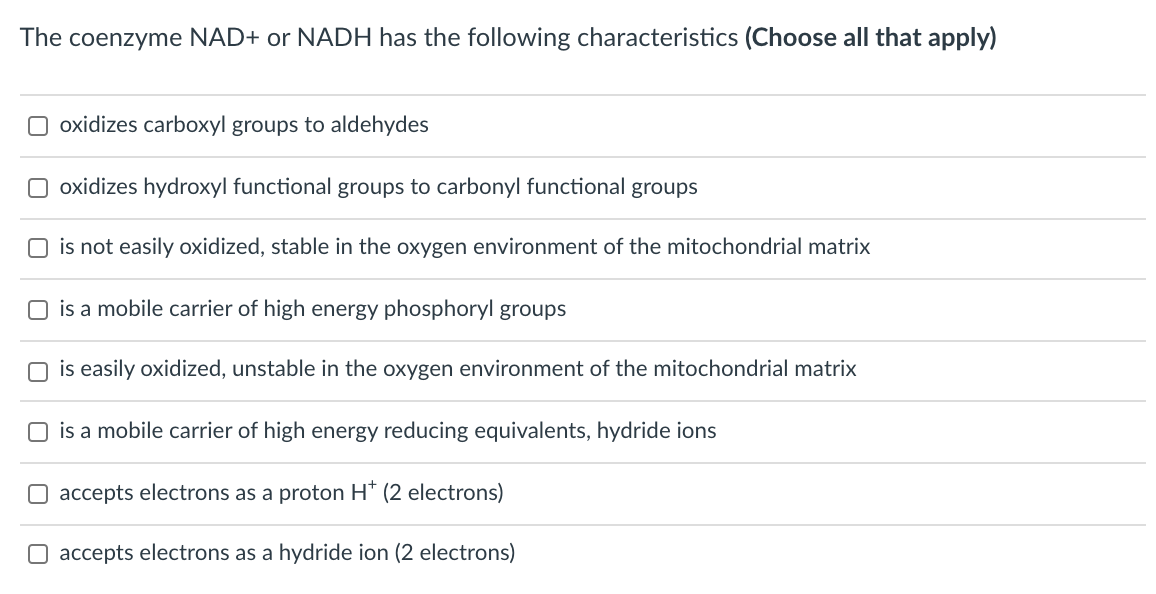The coenzyme NAD+ or NADH has the following characteristics (Choose all that apply) Ooxidizes carboxyl groups to aldehydes oxidizes hydroxyl functional groups to carbonyl functional groups is not easily oxidized, stable in the oxygen environment of the mitochondrial matrix is a mobile carrier of high energy phosphoryl groups O is easily oxidized, unstable in the oxygen environment of the mitochondrial matrix O is a mobile carrier of high energy reducing equivalents, hydride ions O accepts electrons as a proton H+ (2 electrons) O accepts electrons as a hydride ion (2 electrons)
The coenzyme NAD+ or NADH has the following characteristics (Choose all that apply) Ooxidizes carboxyl groups to aldehydes oxidizes hydroxyl functional groups to carbonyl functional groups is not easily oxidized, stable in the oxygen environment of the mitochondrial matrix is a mobile carrier of high energy phosphoryl groups O is easily oxidized, unstable in the oxygen environment of the mitochondrial matrix O is a mobile carrier of high energy reducing equivalents, hydride ions O accepts electrons as a proton H+ (2 electrons) O accepts electrons as a hydride ion (2 electrons)
Human Physiology: From Cells to Systems (MindTap Course List)
9th Edition
ISBN:9781285866932
Author:Lauralee Sherwood
Publisher:Lauralee Sherwood
Chapter2: Cell Physiology
Section: Chapter Questions
Problem 10RE: Using the answer code on the right, indicate which form of energy production is being described: 1....
Related questions
Question

Transcribed Image Text:The coenzyme NAD+ or NADH has the following characteristics (Choose all that apply)
O oxidizes carboxyl groups to aldehydes
O oxidizes hydroxyl functional groups to carbonyl functional groups
is not easily oxidized, stable in the oxygen environment of the mitochondrial matrix
O is a mobile carrier of high energy phosphoryl groups
is easily oxidized, unstable in the oxygen environment of the mitochondrial matrix
is a mobile carrier of high energy reducing equivalents, hydride ions
accepts electrons as a proton H* (2 electrons)
O accepts electrons as a hydride ion (2 electrons)
Expert Solution
Step 1: Reactions involving NAD+ and NADH
NAD+ is a cofactor of many enzymes that catalyze redox reactions. A hydride ion is transferred from a substrate to NAD+. This oxidizes the substrate and reduces NAD+ to NADH.
XH2 + NAD+ X + NADH + H+
'XH2' is the substrate in the forward direction.
Trending now
This is a popular solution!
Step by step
Solved in 3 steps with 1 images

Knowledge Booster
Learn more about
Need a deep-dive on the concept behind this application? Look no further. Learn more about this topic, biochemistry and related others by exploring similar questions and additional content below.Recommended textbooks for you

Human Physiology: From Cells to Systems (MindTap …
Biology
ISBN:
9781285866932
Author:
Lauralee Sherwood
Publisher:
Cengage Learning

Biochemistry
Biochemistry
ISBN:
9781305577206
Author:
Reginald H. Garrett, Charles M. Grisham
Publisher:
Cengage Learning

Human Physiology: From Cells to Systems (MindTap …
Biology
ISBN:
9781285866932
Author:
Lauralee Sherwood
Publisher:
Cengage Learning

Biochemistry
Biochemistry
ISBN:
9781305577206
Author:
Reginald H. Garrett, Charles M. Grisham
Publisher:
Cengage Learning